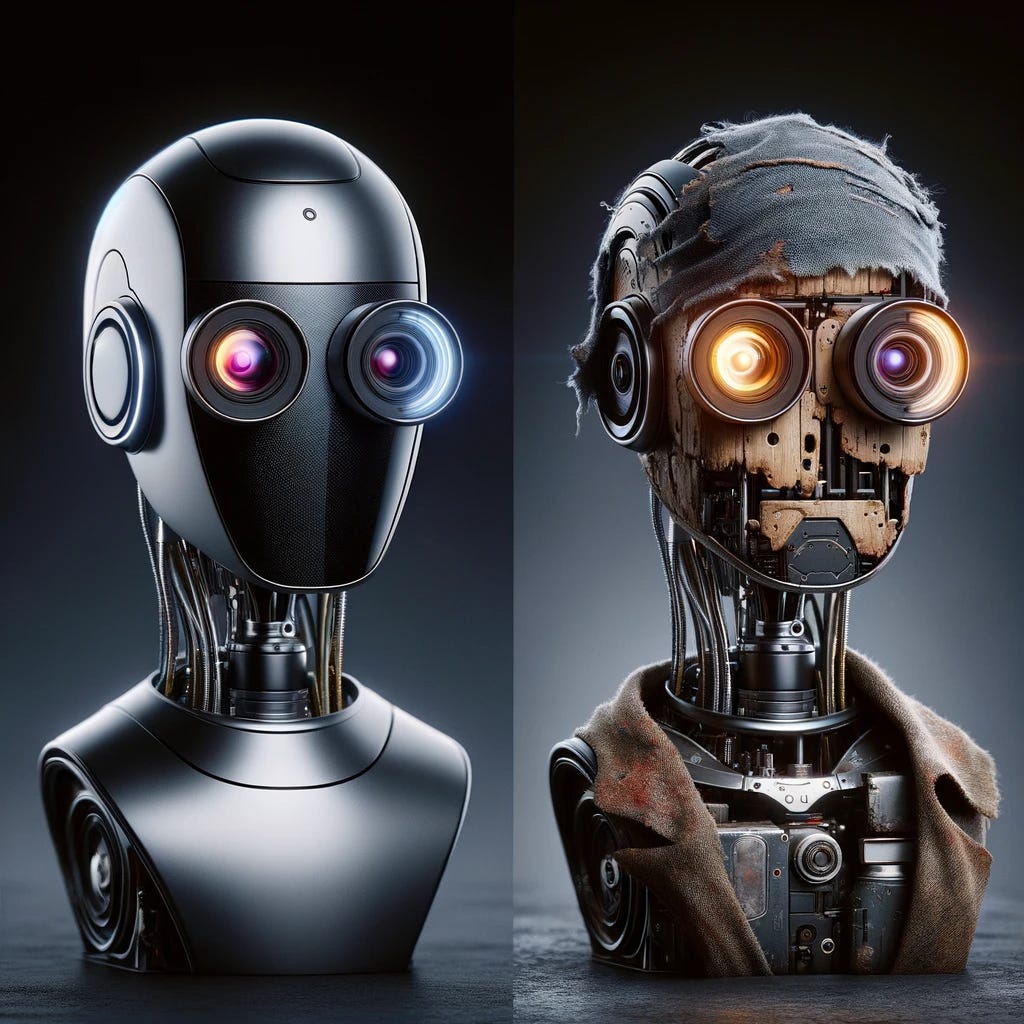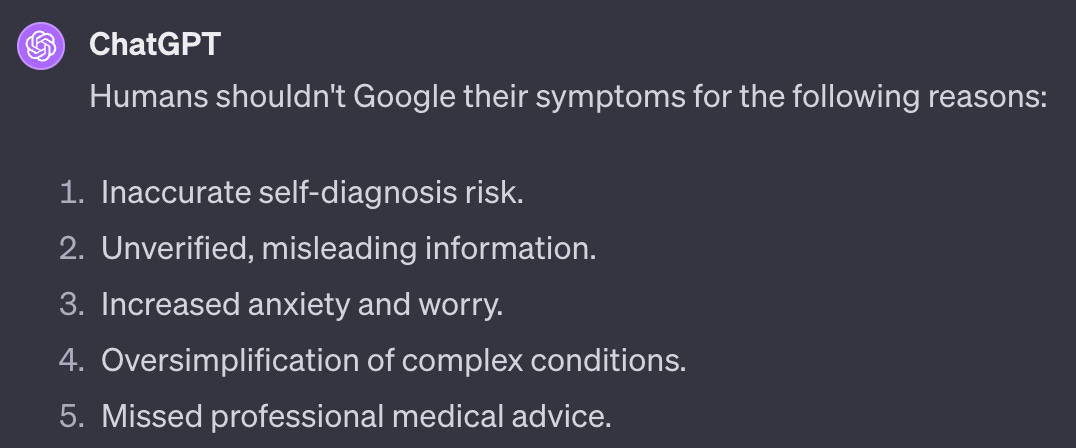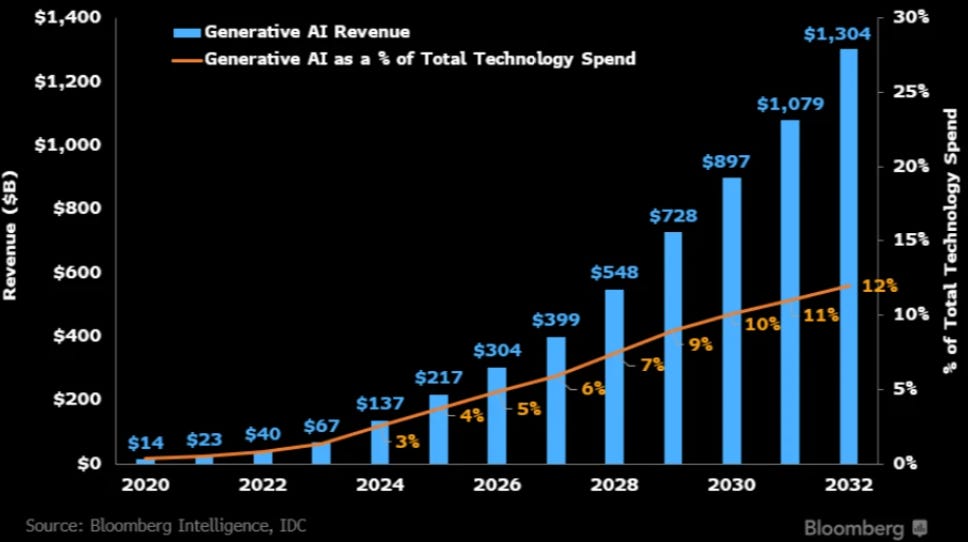AI: A Game of Two Halves - My Personal Journey from Pain to Perspective
#5 | On why our AI dollars need better deployment
I bought into the Gen AI craze with reckless abandon: it’s been convenient for me. But then I needed artificial intelligence for something seemingly more serious.
For this edition, we swapped roles. The masterful Francesco reigned as editor while I wrote this listening to France’s famous masked duo.
It all started with my lower back in southern Italy. My Mrs and I were nearing the end of our holiday and there was a dull throb that signalled my body had entered middle age a decade or so too early.
Obviously, I googled my symptoms. I say symptoms, I mean symptom. Singular. My lack of “problems” meant the internet’s hive mind suggested I had anything from every known cancer on earth to dodgy posture.
Ever since, the “pain” migrated to and from my fingers, wrist, feet, knees, shoulders and neck. But it never returned to my back. It has been stressful and for two reasons: the uncertainty and the prevailing market dynamic.
Stethoscope Stumped! Aching For Answers:
For the best part of two decades, I’ve needed little medical attention. Perhaps it’s luck or my thirst for exercise. However, the past five months has been a crash course in 21st century medicine. Telemedicine, in-person consultants, online bookings, App-based documentation, QR codes, digital certificates and a battery of tests.
The experience has been horrendous but to the countless doctors I’ve seen, it’s been really interesting, curious and nothing to fret about. As one specialist consultant in Madrid confided: “I’m not worried about you! But I am really, really interested.” Great for them, not so much for me.
After a dozen or so tests and consultations I conclusively know what I don’t have. Reassuringly, despite being misdiagnosed twice, all the major showstoppers have been ruled out. But I enter 2024 clueless but kind of comforted that it’ll probably resolve itself.
Misdiagnosis isn't rare. It costs the EU €21 billion annually. That’s near enough the same as Ireland’s public health budget. Across the Atlantic Ocean, 800,000 Americans are devastatingly misdiagnosed every year.
It’s expensive, time-consuming and deadly. Yet here we are, pouring money into AI for chatbots and text-to-image generators but healthcare is an afterthought. Ironic, isn't it?
Market Myopia: AI's Misdirected Focus
As a marketer, I’ve embraced AI with abandon. Whether it’s generating content for the VC firm I work for, overcoming writer’s block or letting Dall-E seize my imagination. As an AI assistant it’s exceptional. It won’t replace me but gone are the days of huge marketing departments.
But, when you're sitting in a doctor's office, waiting for answers, you wonder: Isn't there more to AI than this? Especially when the answers never arrive.
Chatbots and text-to-image platforms are fun but as a former business journalist, I watched how tech commoditised both content and attention. A major LLM will probably fail this year, echoing the new media collapses of Buzzfeed and Vice.
Sure, watching AI whip up cool graphics is terrific fun, but when I think about the healthcare AI market, the numbers are laughably small. We're talking trillions in Gen AI versus billions in healthcare AI. Doesn't quite add up, does it?
Also isn’t capital meant to gravitate towards the greatest efficiencies?
Gen AI’s 2023 market value was €40 billion and is it on course to surpass $1.7 trillion by 2032. Qualcomm puts the ceiling at $7.9 trillion. That’s more than the combined GDPs of Germany and the UK.
By contrast, the market for digital healthcare assistants will hit $17.2 billion by 2032. Another source puts that number at $33 billion by 2036. These are drops in the ocean compared with the trillions elsewhere.
Policymakers, insurers, physicians and patients would join me in arguing that something is amiss.
Beyond the Gimmicks: AI's Real Potential
Some startups are already blending AI with healthcare. Altris AI helps ophthalmologists identify eye disease in patients, like a Grammarly for eye care specialists. The execs of French unicorn Owkin have started Bioptimus and are building an LLM for drug discovery.
Yet, AI has stormed into my every aspect of my life except the most important part of it: my health. It's not just disappointing; it's a wake-up call. The potential for AI in diagnosing diseases is embraced but absent for personalising treatment plans and enhancing patient care. It is as immense as it is non-existent.
Digital assistants in healthcare greatly aid both in-patients and out-patients by managing medications, tracking symptoms, facilitating communication with healthcare staff, providing educational information, assisting in tele-health, offering reminders for appointments and treatment adherence.
They also promise economic efficiency by automating routine tasks and improving decision-making processes. AI can drastically reduce healthcare costs.
Sounds simple? Don’t be foolish. My experience has been plagued with inefficiencies and irritations. Even reminders for appointments are unreliable.
Ryanair’s AI assistance pushes notifications for last minute gate changes at airports. Conversely my private health provider sent me two appointments for the same doctor 30 minutes apart and that was after two phone calls. One doctor uses an app to order lab analysis, another is 100% reliant on his printer.
The damning truth is that a low-cost airline is more equipped to embrace AI than the $7.7 trillion global healthcare market. A €30 flight and a free app has better life-altering personalisation than the entire medical community.
A Glimpse Towards the Future
Today, AI assistants in healthcare are limited due to strict regulatory requirements, privacy and security concerns. There are also integration challenges with legacy systems, and the need for high accuracy.
What’s more is that ethical issues, substantial development costs, resistance to change, and a general lack of understanding about AI among healthcare professionals further impede its widespread adoption.
Doubtless, the techno-optimists among us are unwaveringly confident that if the market wants it, someone will build it.
Well someone has. Cody.md is an AI co-doctor and has served 179,690 humans. I became one of the latest by answering his dozen or so questions about my symptoms and general health, while stressing that a variety of conditions had already been ruled out.
Cody’s diagnosis? There’s a 60% chance it’s Rheumatoid Arthritis and a 10% chance it’s Gout. My doctors conclusively state that Cody is 100% wrong as both conditions have been ruled out but it's onto something. If we put as much effort into healthcare AI as we do into making virtual art, who knows where we could be?
So, here's my two cents: It's high time we reevaluate our fascination with AI. Let's not just use it to add some flair to our LinkedIn posts or to outsource our creativity. Let's push for AI that really matters — AI that heals, diagnoses, and cares.
After all, isn't that the kind of future we all want?






